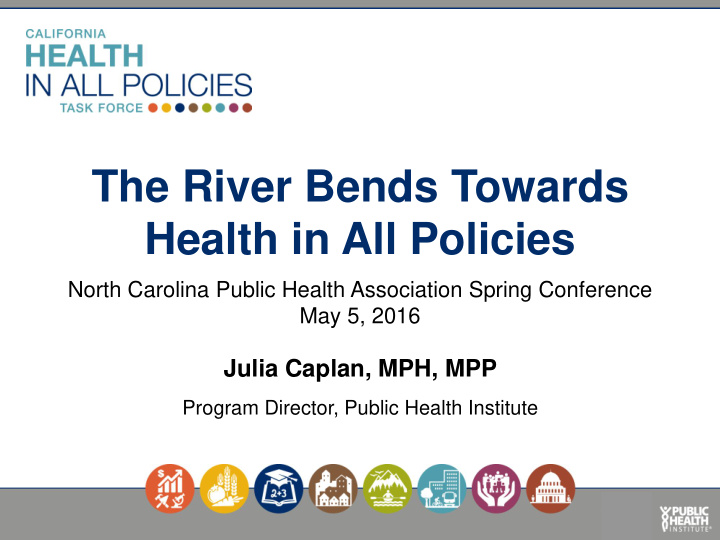



The River Bends Towards Health in All Policies North Carolina Public Health Association Spring Conference May 5, 2016 Julia Caplan, MPH, MPP Program Director, Public Health Institute
2 2
Outline 1. What is a healthy community? 2. Health in All Policies: A new paradigm 3. HiAP in action 4. Equity & environmental sustainability 5. Success factors and next steps 3
The French Broad River in Western North Carolina Source: Visitnc.com/rivers-lakes 4
“ It is unreasonable to expect that people will change their behavior easily when so many forces in the social, cultural, and physical environment conspire against such change.” - Institute of Medicine 5
Sticky or “Wicked” Problems • Multi-factorial • Difficult to fully define • Lack a clear solution • Not the responsibility of any single organization 6
Health in All Policies is… a collaborative approach to improving the health of all people by incorporating health considerations into decision-making across sectors and policy areas. Source: Rudolph, L., Caplan, J., Ben-Moshe, K., & Dillon, L. (2013). Health in All Policies: A Guide for State and Local Governments. Washington, DC and Oakland, CA: American Public Health Association and Public Health Institute. 7
The 5 Key Elements of Health in All Policies 1. Promote health, equity, and environmental sustainability 2. Support intersectoral collaboration 3. Benefit multiple partners 4. Engage stakeholders 5. Create structural or procedural change Source: Rudolph, L., Caplan, J., Ben-Moshe, K., & Dillon, L. (2013). Health in All Policies: A Guide for State and Local Governments. Washington, DC and Oakland, CA: American Public Health Association and Public Health Institute. 8
California Health In All Policies Task Force 9
California Health in All Policies: Climate Change and Childhood Obesity 10
Multi-Agency Work Groups • Active • Housing Siting and Transportation Air Quality • Farm to Fork • Land Use, Schools and Health • Food Procurement • Violence Prevention • Health & Equity in Land Use Planning 11
Public Health’s Role • Convening • Facilitation • Research • Technical assistance • Monitoring and reporting • Subject matter expertise • Draft consensus documents • Stakeholder engagement 12
A Transportation Story 13
Key Element #1: HiAP is about health, equity, and environmental sustainability 14 14
North Carolina Social and Economic Well-Being Indicators • Children and families in poverty • Dropout rates • Percent not owning a home, by race/ethnicity 15 15
North Carolina data: health and social determinants of health African American/Black 21.3 White 21.3% 6.7 6.7% Number of infant deaths per 1,000 live Percent of families living below the births (Infant Mortality Rate) (2008) Federal Poverty Level (2008) Sources : North Carolina State Center for Health Statistics, Vital Statistics, 2014 Statistics for North Carolina; North Carolina Office of Minority Health and Health Disparities and State Center for Health Statistics: Racial and Ethnic Health Disparities Report Card 2010.
Health Inequity: Disparities in health that are a result of systemic, avoidable and unjust social and economic policies and practices that create barriers to opportunity. - Virginia Department of Public Health 17 17
Assumes all people have Ensures all people have the same needs what they need Adapted from: Community View Collaboration of the Saskatoon Health Region, Canada. 18
35% of LGBT Americans live in the South Source: The Williams Institute, University of California, Los Angeles 19 19
Health inequities: LGBT youth • 20% - 40% of homeless youth are LGBT • Overrepresented in child welfare and juvenile justice systems • 63.5% of LGBT students felt unsafe • 81.9% were verbally harassed • 38.3% were physically harassed • Harassment leads to lower grades • 8.4 times more likely to attempt suicide 20 20
Discrimination causes health inequity Differential Differential Discrimination living access to conditions resources Chronic stress Increased Epigenetic allostatic changes load Health inequities: Cancers, heart disease, high 21 blood pressure, kidney disease, etc.
Applying an Equity Lens How might this decision affect different groups? 22 22
American College of Physicians: “Climate change is already harming people's health” Doctors Issue Call to Combat Climate Change They say respiratory illnesses, heat stroke and infectious diseases are growing threats due to a warmer planet - HealthDay, National Institute of Health Monday, April 18, 2016 • Respiratory illnesses • Ozone pollution, smoke, allergens • Toxic mold and fungi • Heat exhaustion and heat stroke • Insect-borne illnesses • Water-borne illnesses • Mental health disorders -- Wayne Riley, M.D., president, American College of Physicians 23 23
Public Health and Climate Change in North Carolina According to the Federal government, North Carolina is vulnerable to: • Sea level rise and increasing storm surge • Drought and decreased water availability • Extreme heat events • Hurricanes • Mold and allergens • Insects and pathogens • Reduced crop productivity Who is most vulnerable? 24 24
Comic by Joel Pett 25 25
How wo wonderful ful it is that t nobody dy need wait t a si single gle moment nt befor ore e begin inni ning ng to to impr prov ove the wo world ld. . - Anne Fran ank 26
HiAP is Spreading • Baltimore, Maryland • Chicago, Illinois • Del Norte County, California • Galveston, Texas • Monterey County, California • Nashville, Tennessee • New Orleans, Louisiana 27
28
What will YOU do? 29
Health in All Policies: A Guide for State and Local Governments (October 2013) • What is HiAP and Why Do We Need It? • The Nuts and Bolts of HiAP • Getting Started • Partners and Roles • Working Together Across Sectors • Structures to Support HiAP • Creating Healthy Public Policy • Talking about HiAP • Case Study: California HiAP Task Force • Appendices 30
For more information Julia Caplan, HiAP Task Force Program Director: julia.caplan@cdph.ca.gov HiAP Task Force website: http://sgc.ca.gov/s_hiap.php 31
Recommend
More recommend